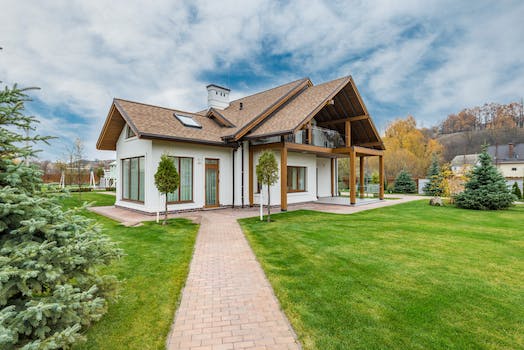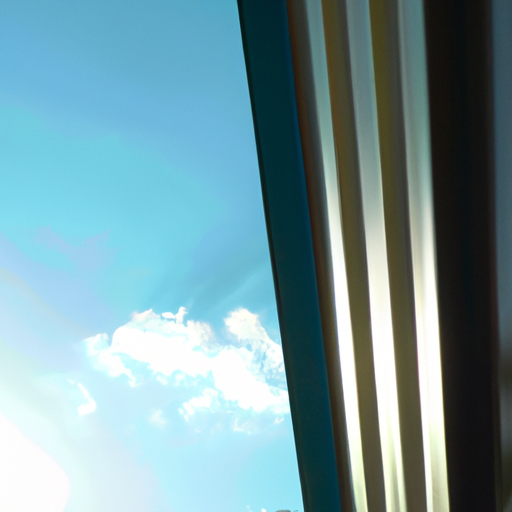Exploring the Relationship between Roof Design and Home Architecture
The impact of roof design on your home’s architecture cannot be overstated. As one of the most visible and defining elements of a building, the roof plays a crucial role in shaping the overall aesthetic and character of a home. In addition to providing shelter and protection from the elements, the roof also contributes to the structural integrity and energy efficiency of a building. As such, it is essential to carefully consider the relationship between roof design and home architecture when planning a new construction or renovation project.
One of the most significant ways in which roof design influences home architecture is through the choice of roof shape. The shape of a roof can dramatically alter the appearance of a building, creating a distinct architectural style. For instance, a gable roof, characterized by its triangular shape, is a classic feature of traditional homes, while a flat roof lends a modern, minimalist look to a building. Similarly, a curved or domed roof can create a unique, eye-catching architectural statement. The choice of roof shape not only affects the visual appeal of a home but also has practical implications, such as the ability to shed water and snow, provide attic space, and withstand wind loads.
Another important aspect of roof design is the choice of roofing materials. The materials used for a roof can greatly impact the overall look and feel of a home, as well as its durability and energy efficiency. Traditional materials such as clay tiles, slate, and wood shingles can lend a timeless, natural appearance to a building, while metal roofing and synthetic materials offer a sleek, contemporary aesthetic. The choice of roofing materials should not only complement the architectural style of a home but also take into account factors such as climate, maintenance requirements, and budget.
The color of a roof is another crucial element in the relationship between roof design and home architecture. The right roof color can enhance the visual appeal of a building, create a sense of harmony with the surrounding environment, and even improve energy efficiency by reflecting or absorbing sunlight. A well-chosen roof color can also help to emphasize or downplay certain architectural features, such as dormers, eaves, and gables. When selecting a roof color, it is essential to consider the overall color scheme of the home, as well as the desired effect on the building’s appearance and energy performance.
In addition to shape, materials, and color, the design of a roof can also incorporate various architectural features that contribute to the character and functionality of a home. For example, dormer windows can add visual interest to a roofline while providing additional living space and natural light. Similarly, skylights can create a sense of openness and connection to the outdoors, while also improving the energy efficiency of a home by reducing the need for artificial lighting. Other roof features, such as eaves, overhangs, and gutters, can also play a significant role in the overall design and performance of a building.
In conclusion, the impact of roof design on your home’s architecture is multifaceted, encompassing aspects such as shape, materials, color, and architectural features. A well-designed roof not only enhances the visual appeal and character of a building but also contributes to its structural integrity, energy efficiency, and functionality. By carefully considering the relationship between roof design and home architecture, homeowners and architects can create a harmonious, aesthetically pleasing, and high-performing building that meets the needs and preferences of its occupants.
The Influence of Roof Styles on a Home’s Aesthetic Appeal and Functionality

The impact of roof design on your home’s architecture cannot be overstated. A well-designed roof not only provides protection from the elements but also contributes significantly to the overall aesthetic appeal and functionality of a home. Roof styles have evolved over time, influenced by factors such as climate, available materials, and cultural preferences. Today, homeowners have a wide array of roof designs to choose from, each with its unique characteristics and benefits.
One of the most significant ways in which roof design impacts a home’s architecture is through its visual appeal. The roof is often the first thing people notice when they look at a house, and it can set the tone for the entire structure. A steeply pitched roof, for example, can create a sense of grandeur and drama, while a flat roof may convey a more modern, minimalist aesthetic. The choice of roofing materials also plays a crucial role in defining a home’s appearance. Traditional materials such as slate, wood shakes, and clay tiles can lend a timeless, classic look, while metal roofing and synthetic materials can create a sleek, contemporary vibe.
In addition to its aesthetic impact, roof design also plays a critical role in a home’s functionality. The primary function of a roof is to protect the home and its occupants from the elements, and different roof styles are better suited to different climates and weather conditions. For instance, a gable roof, with its triangular shape and steep pitch, is excellent at shedding snow and rain, making it a popular choice in areas with heavy precipitation. On the other hand, a hip roof, with its sloping sides, offers better wind resistance and is more suitable for hurricane-prone regions.
Roof design can also influence a home’s energy efficiency. A well-insulated roof can help keep a house cool in the summer and warm in the winter, reducing the need for air conditioning and heating. The choice of roofing materials can also impact energy efficiency. For example, metal roofing can reflect solar heat, helping to keep a home cooler in hot climates. Additionally, the color of the roofing material can affect the amount of heat absorbed by the roof. Light-colored roofs tend to reflect more sunlight and stay cooler, while dark-colored roofs absorb more heat.
Another aspect of roof design that can impact a home’s functionality is the potential for additional living space. Certain roof styles, such as mansard and gambrel roofs, can provide extra attic space that can be converted into bedrooms, offices, or storage areas. This can be particularly valuable in urban areas where space is at a premium.
Lastly, the choice of roof design can have implications for a home’s maintenance requirements. Some roof styles, such as flat roofs, may require more frequent maintenance due to their tendency to collect debris and water. The choice of roofing materials can also affect maintenance needs. For example, wood shakes and shingles may require more upkeep than metal or synthetic materials, which are more resistant to weathering and decay.
In conclusion, the impact of roof design on a home’s architecture is multifaceted, encompassing both aesthetic appeal and functionality. Homeowners should carefully consider their options when selecting a roof style, taking into account factors such as climate, energy efficiency, maintenance requirements, and the potential for additional living space. By making an informed decision, homeowners can ensure that their roof not only enhances the beauty of their home but also contributes to its long-term durability and performance.
Innovative Roof Designs: Transforming the Architectural Landscape of Modern Homes
The impact of roof design on your home’s architecture cannot be overstated. As one of the most visible and defining elements of a building, the roof plays a crucial role in shaping the overall aesthetic and character of a home. In recent years, innovative roof designs have emerged as a transformative force in the architectural landscape of modern homes, pushing the boundaries of traditional forms and materials to create striking and functional structures that enhance the beauty and value of a property.
One of the most significant trends in contemporary roof design is the shift towards sustainability and energy efficiency. As homeowners become increasingly aware of the environmental impact of their choices, architects and designers are responding with innovative solutions that not only reduce a home’s carbon footprint but also contribute to its visual appeal. Green roofs, for example, are gaining popularity for their ability to absorb rainwater, provide insulation, and create a habitat for wildlife. These living roofs, often covered with a layer of vegetation, can be designed in various shapes and sizes, adding a unique and eye-catching element to a home’s exterior.
Another notable development in roof design is the growing use of solar panels and other renewable energy technologies. Integrated solar roofs, which seamlessly blend photovoltaic cells into the roofing material, offer a sleek and modern alternative to traditional solar panels. These innovative systems not only generate clean energy for the home but also contribute to its aesthetic appeal by creating a smooth and uniform surface that complements the overall architectural style.
In addition to sustainability, modern roof designs are also characterized by their bold and unconventional forms. Gone are the days when roofs were limited to simple gable or hip shapes; today’s architects are experimenting with a wide range of geometric configurations to create visually striking structures that challenge the traditional notion of what a roof should look like. Curved and undulating rooflines, for example, can add a dynamic and sculptural quality to a home, while angular and asymmetrical designs can create a sense of movement and tension that captures the eye.
The choice of roofing materials also plays a significant role in shaping the appearance and performance of a roof. While traditional materials like asphalt shingles, clay tiles, and slate continue to be popular choices, a growing number of homeowners are exploring alternative options that offer unique aesthetic and functional benefits. Metal roofing, for instance, is gaining traction for its durability, low maintenance, and ability to reflect heat, making it an energy-efficient choice for many climates. Moreover, metal roofs can be designed in a variety of colors and finishes, allowing homeowners to customize the look of their home to suit their personal taste and style.
Lastly, the integration of roof design with other architectural elements is essential in creating a cohesive and harmonious exterior. By carefully considering the relationship between the roof and features such as windows, doors, and cladding, architects can create a unified and balanced composition that enhances the overall appeal of a home. For example, the use of matching or complementary materials for the roof and facade can create a seamless transition between the two, while the strategic placement of windows and skylights can maximize natural light and ventilation, improving the comfort and livability of the interior spaces.
In conclusion, the impact of roof design on your home’s architecture is profound, with innovative roof designs transforming the architectural landscape of modern homes. By embracing sustainability, experimenting with bold forms, and carefully selecting materials and integrating them with other architectural elements, homeowners can create a visually stunning and functional roof that not only protects their home but also elevates its aesthetic appeal and value.
Q&A
Question 1: How does roof design affect the overall aesthetic of a home’s architecture?
Answer: Roof design plays a significant role in determining the overall aesthetic of a home’s architecture. It contributes to the visual appeal, proportion, and balance of the structure. Different roof styles, such as gable, hip, or flat roofs, can create distinct architectural styles, such as modern, traditional, or contemporary, and can also complement or contrast with the surrounding environment.
Question 2: How does roof design impact a home’s energy efficiency?
Answer: Roof design can greatly impact a home’s energy efficiency. Factors such as roof material, color, insulation, and ventilation can influence the amount of heat absorbed or reflected by the roof, affecting the indoor temperature and energy consumption for heating and cooling. For example, a light-colored roof can reflect more sunlight, reducing heat absorption and keeping the home cooler in hot climates, while a well-insulated roof can help maintain indoor temperatures and reduce energy costs.
Question 3: How can roof design affect the durability and maintenance requirements of a home?
Answer: Roof design can influence the durability and maintenance requirements of a home. A well-designed roof can effectively shed water and prevent moisture buildup, reducing the risk of leaks, mold, and structural damage. The choice of roofing materials, such as asphalt shingles, metal, or clay tiles, can also impact the lifespan and maintenance needs of the roof. Additionally, complex roof designs with multiple valleys and intersections may require more frequent inspections and maintenance to ensure proper water drainage and prevent potential issues.
Conclusion
In conclusion, the roof design plays a significant role in a home’s architecture as it influences the overall aesthetic appeal, structural integrity, energy efficiency, and functionality of the house. A well-designed roof not only enhances the visual appearance of the home but also provides protection against various weather conditions, contributes to energy savings, and ensures proper ventilation and insulation. Therefore, careful consideration of roof design is essential in creating a harmonious and efficient living space.


